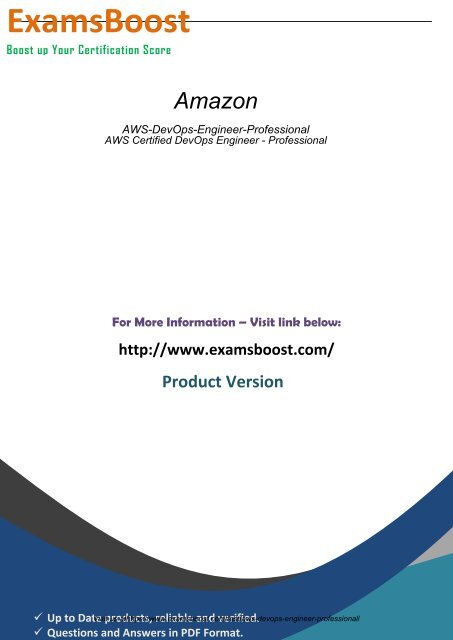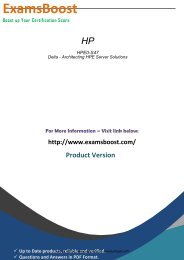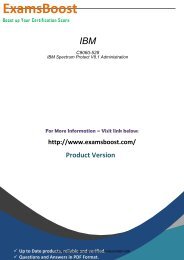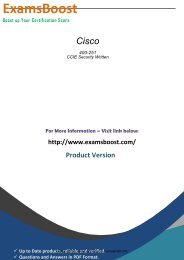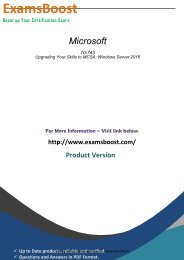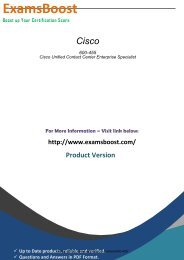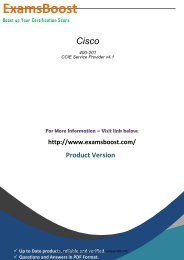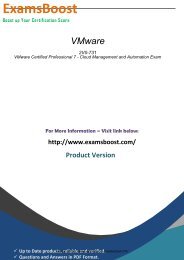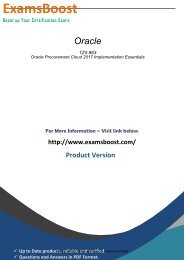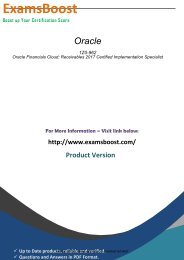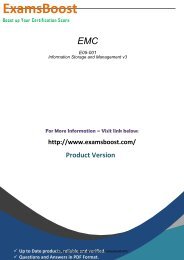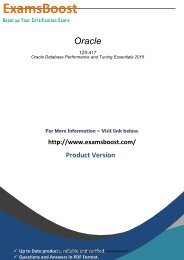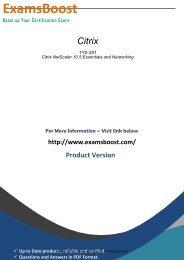AWS-DevOps-Engineer-Professional Coaching Kits
Study kits and preparation materials provided by us for AWS-DevOps-Engineer-Professional Test are authorized by the professionals and industry experts. You can easily pass your certification test with our brain dumps and PDF sample questions. For more info please visit here: http://www.examsboost.com/test/AWS-DevOps-Engineer-Professional/
Study kits and preparation materials provided by us for AWS-DevOps-Engineer-Professional Test are authorized by the professionals and industry experts. You can easily pass your certification test with our brain dumps and PDF sample questions. For more info please visit here: http://www.examsboost.com/test/AWS-DevOps-Engineer-Professional/
You also want an ePaper? Increase the reach of your titles
YUMPU automatically turns print PDFs into web optimized ePapers that Google loves.
ExamsBoost<br />
Boost up Your Certification Score<br />
Amazon<br />
<strong>AWS</strong>-<strong>DevOps</strong>-<strong>Engineer</strong>-<strong>Professional</strong><br />
<strong>AWS</strong> Certified <strong>DevOps</strong> <strong>Engineer</strong> - <strong>Professional</strong><br />
For More Information – Visit link below:<br />
http://www.examsboost.com/<br />
Product Version<br />
Up to Date products, reliable and verified.<br />
Questions and Answers in PDF Format.<br />
Visit us athttps://www.examsboost.com/test/aws-devops-engineer-professional/
Question: 1<br />
What is server immutability?<br />
A. Not updating a server after creation.<br />
B. The ability to change server counts.<br />
C. Updating a server after creation.<br />
D. The inability to change server counts.<br />
Answer: A<br />
Explanation:<br />
... disposable upgrades offer a simpler way to know if your application has unknown dependencies. The<br />
underlying EC2 instance usage is considered temporary or ephemeral in nature for the period of<br />
deployment until the current release is active. During the new release, a new set of EC2 instances are<br />
rolled out by terminating older instances. This type of upgrade technique is more common in an<br />
immutable infrastructure.<br />
Reference: https://d0.awsstatic.com/whitepapers/overview-of-deployment-options-on-aws.pdf<br />
Question: 2<br />
You run a clustered NoSQL database on <strong>AWS</strong> EC2 using <strong>AWS</strong> EBS. You need to reduce latency for<br />
database response times. Performance is the most important concern, not availability. You did not<br />
perform the initial setup, someone without much <strong>AWS</strong> knowledge did, so you are not sure if they<br />
configured everything optimally. Which of the following is NOT likely to be an issue contributing to<br />
increased latency?<br />
A. The EC2 instances are not EBS Optimized.<br />
B. The database and requesting system are both in the wrong Availability Zone.<br />
C. The EBS Volumes are not using PIOPS.<br />
D. The database is not running in a placement group.<br />
Answer: B<br />
Explanation:<br />
For the highest possible performance, all instances in a clustered database like this one should be in a<br />
single Availability Zone in a placement group, using EBS optimized instances, and using PIOPS SSD EBS<br />
Volumes. The particular Availability Zone the system is running in should not be important, as long as it<br />
is the same as the requesting resources.<br />
Reference: http://docs.aws.amazon.com/<strong>AWS</strong>EC2/latest/UserGuide/placement-groups.html<br />
Visit us athttps://www.examsboost.com/test/aws-devops-engineer-professional/
Question: 3<br />
Fill the blanks: __________ helps us track <strong>AWS</strong> API calls and transitions, _________ helps to understand<br />
what resources we have now, and ________ allows auditing credentials and logins.<br />
A. <strong>AWS</strong> Config, CloudTrail, IAM Credential Reports<br />
B. CloudTrail, IAM Credential Reports, <strong>AWS</strong> Config<br />
C. CloudTrail, <strong>AWS</strong> Config, IAM Credential Reports<br />
D. <strong>AWS</strong> Config, IAM Credential Reports, CloudTrail<br />
Answer: C<br />
Explanation:<br />
You can use <strong>AWS</strong> CloudTrail to get a history of <strong>AWS</strong> API calls and related events for your account. This<br />
includes calls made by using the <strong>AWS</strong> Management Console, <strong>AWS</strong> SDKs, command line tools, and<br />
higher-level <strong>AWS</strong> services.<br />
Reference: http://docs.aws.amazon.com/awscloudtrail/latest/userguide/cloudtrail-user-guide.html<br />
Question: 4<br />
You are creating an application which stores extremely sensitive financial information. All information in<br />
the system must be encrypted at rest and in transit. Which of these is a violation of this policy?<br />
A. ELB SSL termination.<br />
B. ELB Using Proxy Protocol v1.<br />
C. CloudFront Viewer Protocol Policy set to HTTPS redirection.<br />
D. Telling S3 to use AES256 on the server-side.<br />
Answer: A<br />
Explanation:<br />
Terminating SSL terminates the security of a connection over HTTP, removing the S for "Secure" in<br />
HTTPS. This violates the "encryption in transit" requirement in the scenario.<br />
Reference:<br />
http://docs.aws.amazon.com/ElasticLoadBalancing/latest/DeveloperGuide/elb-listener-config.html<br />
Question: 5<br />
You need to scale an RDS deployment. You are operating at 10% writes and 90% reads, based on your<br />
logging. How best can you scale this in a simple way?<br />
Visit us athttps://www.examsboost.com/test/aws-devops-engineer-professional/
A. Create a second master RDS instance and peer the RDS groups.<br />
B. Cache all the database responses on the read side with CloudFront.<br />
C. Create read replicas for RDS since the load is mostly reads.<br />
D. Create a Multi-AZ RDS installs and route read traffic to standby.<br />
Answer: C<br />
Explanation:<br />
The high-availability feature is not a scaling solution for read-only scenarios; you cannot use a standby<br />
replica to serve read traffic. To service read-only traffic, you should use a Read Replica. For more<br />
information, see Working with PostgreSQL, MySQL, and MariaDB Read Replicas.<br />
Reference: http://docs.aws.amazon.com/AmazonRDS/latest/UserGuide/Concepts.MultiAZ.html<br />
Question: 6<br />
When thinking of <strong>AWS</strong> Elastic Beanstalk, the 'Swap Environment URLs' feature most directly aids in<br />
what?<br />
A. Immutable Rolling Deployments<br />
B. Mutable Rolling Deployments<br />
C. Canary Deployments<br />
D. Blue-Green Deployments<br />
Answer: D<br />
Explanation:<br />
Simply upload the new version of your application and let your deployment service (<strong>AWS</strong> Elastic<br />
Beanstalk, <strong>AWS</strong> CloudFormation, or <strong>AWS</strong> OpsWorks) deploy a new version (green). To cut over to the<br />
new version, you simply replace the ELB URLs in your DNS records. Elastic Beanstalk has a Swap<br />
Environment URLs feature to facilitate a simpler cutover process.<br />
Reference: https://d0.awsstatic.com/whitepapers/overview-of-deployment-options-on-aws.pdf<br />
Question: 7<br />
You need your CI to build AMIs with code pre-installed on the images on every new code push. You need<br />
to do this as cheaply as possible. How do you do this?<br />
A. Bid on spot instances just above the asking price as soon as new commits come in, perform all<br />
instance configuration and setup, then create an AMI based on the spot instance.<br />
B. Have the CI launch a new on-demand EC2 instance when new commits come in, perform all instance<br />
configuration and setup, then create an AMI based on the on-demand instance.<br />
Visit us athttps://www.examsboost.com/test/aws-devops-engineer-professional/
C. Purchase a Light Utilization Reserved Instance to save money on the continuous integration machine.<br />
Use these credits whenever your create AMIs on instances.<br />
D. When the CI instance receives commits, attach a new EBS volume to the CI machine. Perform all<br />
setup on this EBS volume so you don't need a new EC2 instance to create the AMI.<br />
Answer: A<br />
Explanation:<br />
Spot instances are the cheapest option, and you can use minimum run duration if your AMI takes more<br />
than a few minutes to create.<br />
Spot instances are also available to run for a predefined duration – in hourly increments up to six hours<br />
in length – at a significant discount (30-45%) compared to On-Demand pricing plus an additional 5%<br />
during off-peak times1 for a total of up to 50% savings.<br />
Reference: https://aws.amazon.com/ec2/spot/pricing/<br />
Question: 8<br />
When thinking of DynamoDB, what are true of Global Secondary Key properties?<br />
A. The partition key and sort key can be different from the table.<br />
B. Only the partition key can be different from the table.<br />
C. Either the partition key or the sort key can be different from the table, but not both.<br />
D. Only the sort key can be different from the table.<br />
Answer: A<br />
Explanation:<br />
Global secondary index — an index with a partition key and a sort key that can be different from those<br />
on the table. A global secondary index is considered "global" because queries on the index can span all<br />
of the data in a table, across all partitions.<br />
Reference:<br />
http://docs.aws.amazon.com/amazondynamodb/latest/developerguide/SecondaryIndexes.html<br />
Question: 9<br />
You need to process long-running jobs once and only once. How might you do this?<br />
A. Use an SNS queue and set the visibility timeout to long enough for jobs to process.<br />
B. Use an SQS queue and set the reprocessing timeout to long enough for jobs to process.<br />
C. Use an SQS queue and set the visibility timeout to long enough for jobs to process.<br />
D. Use an SNS queue and set the reprocessing timeout to long enough for jobs to process.<br />
Visit us athttps://www.examsboost.com/test/aws-devops-engineer-professional/
Answer: C<br />
Explanation:<br />
The message timeout defines how long after a successful receive request SQS waits before allowing jobs<br />
to be seen by other components, and proper configuration prevents duplicate processing.<br />
Reference:<br />
http://docs.aws.amazon.com/<strong>AWS</strong>SimpleQueueService/latest/SQSDeveloperGuide/MessageLifecycle.ht<br />
ml<br />
Question: 10<br />
You are designing a service that aggregates clickstream data in batch and delivers reports to subscribers<br />
via email only once per week. Data is extremely spikey, geographically distributed, high-scale, and<br />
unpredictable. How should you design this system?<br />
A. Use a large RedShift cluster to perform the analysis, and a fleet of Lambdas to perform record inserts<br />
into the RedShift tables. Lambda will scale rapidly enough for the traffic spikes.<br />
B. Use a CloudFront distribution with access log delivery to S3. Clicks should be recorded as querystring<br />
GETs to the distribution. Reports are built and sent by periodically running EMR jobs over the access logs<br />
in S3.<br />
C. Use API Gateway invoking Lambdas which PutRecords into Kinesis, and EMR running Spark<br />
performing GetRecords on Kinesis to scale with spikes. Spark on EMR outputs the analysis to S3, which<br />
are sent out via email.<br />
D. Use <strong>AWS</strong> Elasticsearch service and EC2 Auto Scaling groups. The Autoscaling groups scale based on<br />
click throughput and stream into the Elasticsearch domain, which is also scalable. Use Kibana to<br />
generate reports periodically.<br />
Answer: B<br />
Explanation:<br />
Because you only need to batch analyze, anything using streaming is a waste of money. CloudFront is a<br />
Gigabit-Scale HTTP(S) global request distribution service, so it can handle scale, geo-spread, spikes, and<br />
unpredictability. The Access Logs will contain the GET data and work just fine for batch analysis and<br />
email using EMR.<br />
Can I use Amazon CloudFront if I expect usage peaks higher than 10 Gbps or 15,000 RPS? Yes. Complete<br />
our request for higher limits here, and we will add more capacity to your account within two business<br />
days.<br />
Reference: https://aws.amazon.com/cloudfront/faqs/<br />
Question: 11<br />
Your system automatically provisions EIPs to EC2 instances in a VPC on boot. The system provisions the<br />
whole VPC and stack at once. You have two of them per VPC. On your new <strong>AWS</strong> account, your attempt<br />
Visit us athttps://www.examsboost.com/test/aws-devops-engineer-professional/
to create a Development environment failed, after successfully creating Staging and Production<br />
environments in the same region. What happened?<br />
A. You didn't choose the Development version of the AMI you are using.<br />
B. You didn't set the Development flag to true when deploying EC2 instances.<br />
C. You hit the soft limit of 5 EIPs per region and requested a 6th.<br />
D. You hit the soft limit of 2 VPCs per region and requested a 3rd.<br />
Answer: C<br />
Explanation:<br />
There is a soft limit of 5 EIPs per Region for VPC on new accounts. The third environment could not<br />
allocate the 6th EIP.<br />
Reference: http://docs.aws.amazon.com/general/latest/gr/aws_service_limits.html#limits_vpc<br />
Question: 12<br />
To monitor API calls against our <strong>AWS</strong> account by different users and entities, we can use ________ to<br />
create a history of calls in bulk for later review, and use ___________ for reacting to <strong>AWS</strong> API calls in<br />
real-time.<br />
A. <strong>AWS</strong> Config; <strong>AWS</strong> Inspector<br />
B. <strong>AWS</strong> CloudTrail; <strong>AWS</strong> Config<br />
C. <strong>AWS</strong> CloudTrail; CloudWatch Events<br />
D. <strong>AWS</strong> Config; <strong>AWS</strong> Lambda<br />
Answer: C<br />
Explanation:<br />
CloudTrail is a batch API call collection service, CloudWatch Events enables real-time monitoring of calls<br />
through the Rules object interface.<br />
Reference: https://aws.amazon.com/whitepapers/security-at-scale-governance-in-aws/<br />
Question: 13<br />
How does Amazon RDS multi Availability Zone model work?<br />
A. A second, standby database is deployed and maintained in a different availability zone from master,<br />
using synchronous replication.<br />
B. A second, standby database is deployed and maintained in a different availability zone from master<br />
using asynchronous replication.<br />
Visit us athttps://www.examsboost.com/test/aws-devops-engineer-professional/
C. A second, standby database is deployed and maintained in a different region from master using<br />
asynchronous replication.<br />
D. A second, standby database is deployed and maintained in a different region from master using<br />
synchronous replication.<br />
Answer: A<br />
Explanation:<br />
In a Multi-AZ deployment, Amazon RDS automatically provisions and maintains a synchronous standby<br />
replica in a different Availability Zone.<br />
Reference: http://docs.aws.amazon.com/AmazonRDS/latest/UserGuide/Concepts.MultiAZ.html<br />
Question: 14<br />
Which of these is not an instrinsic function in <strong>AWS</strong> CloudFormation?<br />
A. Fn::Equals<br />
B. Fn::If<br />
C. Fn::Not<br />
D. Fn::Parse<br />
Answer: D<br />
Explanation:<br />
This is the complete list of Intrinsic Functions...: Fn::Base64, Fn::And, Fn::Equals, Fn::If, Fn::Not, Fn::Or,<br />
Fn::FindInMap, Fn::GetAtt, Fn::GetAZs, Fn::Join, Fn::Select, Ref<br />
Reference:<br />
http://docs.aws.amazon.com/<strong>AWS</strong>CloudFormation/latest/UserGuide/intrinsic-function-reference.html<br />
Question: 15<br />
What method should I use to author automation if I want to wait for a CloudFormation stack to finish<br />
completing in a script?<br />
A. Event subscription using SQS.<br />
B. Event subscription using SNS.<br />
C. Poll using ListStacks / list-stacks.<br />
D. Poll using GetStackStatus / get-stack-status.<br />
Visit us athttps://www.examsboost.com/test/aws-devops-engineer-professional/
Answer: C<br />
Explanation:<br />
Event driven systems are good for IFTTT logic, but only polling will make a script wait to complete.<br />
ListStacks / list-stacks is a real method, GetStackStatus / get-stack-status is not.<br />
Reference: http://docs.aws.amazon.com/cli/latest/reference/cloudformation/list-stacks.html<br />
Question: 16<br />
Your application consists of 10% writes and 90% reads. You currently service all requests through a<br />
Route53 Alias Record directed towards an <strong>AWS</strong> ELB, which sits in front of an EC2 Auto Scaling Group.<br />
Your system is getting very expensive when there are large traffic spikes during certain news events,<br />
during which many more people request to read similar data all at the same time. What is the simplest<br />
and cheapest way to reduce costs and scale with spikes like this?<br />
A. Create an S3 bucket and asynchronously replicate common requests responses into S3 objects. When<br />
a request comes in for a precomputed response, redirect to <strong>AWS</strong> S3.<br />
B. Create another ELB and Auto Scaling Group layer mounted on top of the other system, adding a tier<br />
to the system. Serve most read requests out of the top layer.<br />
C. Create a CloudFront Distribution and direct Route53 to the Distribution. Use the ELB as an Origin and<br />
specify Cache Behaviours to proxy cache requests which can be served late.<br />
D. Create a Memcached cluster in <strong>AWS</strong> ElastiCache. Create cache logic to serve requests which can be<br />
served late from the in-memory cache for increased performance.<br />
Answer: C<br />
Explanation:<br />
CloudFront is ideal for scenarios in which entire requests can be served out of a cache and usage<br />
patterns involve heavy reads and spikiness in demand.<br />
A cache behavior is the set of rules you configure for a given URL pattern based on file extensions, file<br />
names, or any portion of a URL path on your website (e.g., *.jpg). You can configure multiple cache<br />
behaviors for your web distribution. Amazon CloudFront will match incoming viewer requests with your<br />
list of URL patterns, and if there is a match, the service will honor the cache behavior you configure for<br />
that URL pattern. Each cache behavior can include the following Amazon CloudFront configuration<br />
values: origin server name, viewer connection protocol, minimum expiration period, query string<br />
parameters, cookies, and trusted signers for private content.<br />
Reference: https://aws.amazon.com/cloudfront/dynamic-content/<br />
Question: 17<br />
You need to perform ad-hoc business analytics queries on well-structured data. Data comes in<br />
constantly at a high velocity. Your business intelligence team can understand SQL. What <strong>AWS</strong> service(s)<br />
should you look to first?<br />
Visit us athttps://www.examsboost.com/test/aws-devops-engineer-professional/
A. Kinesis Firehose + RDS<br />
B. Kinesis Firehose + RedShift<br />
C. EMR using Hive<br />
D. EMR running Apache Spark<br />
Answer: B<br />
Explanation:<br />
Kinesis Firehose provides a managed service for aggregating streaming data and inserting it into<br />
RedShift. RedShift also supports ad-hoc queries over well-structured data using a SQL-compliant wire<br />
protocol, so the business team should be able to adopt this system easily.<br />
Reference: https://aws.amazon.com/kinesis/firehose/details/<br />
Question: 18<br />
You are building a game high score table in DynamoDB. You will store each user's highest score for each<br />
game, with many games, all of which have relatively similar usage levels and numbers of players. You<br />
need to be able to look up the highest score for any game. What's the best DynamoDB key structure?<br />
A. HighestScore as the hash / only key.<br />
B. GameID as the hash key, HighestScore as the range key.<br />
C. GameID as the hash / only key.<br />
D. GameID as the range / only key.<br />
Answer: B<br />
Explanation:<br />
Since access and storage for games is uniform, and you need to have ordering within each game for the<br />
scores (to access the highest value), your hash (partition) key should be the GameID, and there should<br />
be a range key for HighestScore.<br />
Reference:<br />
http://docs.aws.amazon.com/amazondynamodb/latest/developerguide/GuidelinesForTables.html#Guid<br />
elinesForTables.Partitions<br />
Visit us athttps://www.examsboost.com/test/aws-devops-engineer-professional/
Powered by TCPDF (www.tcpdf.org)<br />
Thank You for Trying Our Product<br />
For More Information – Visit link below:<br />
http://www.examsboost.com/<br />
FEATURES<br />
90 Days Free Updates<br />
Money Back Pass Guarantee<br />
Instant Download or Email Attachment<br />
24/7 Live Chat Support<br />
PDF file could be used at any Platform<br />
50,000 Happy Customer<br />
WE ACCEPT<br />
Visit us athttps://www.examsboost.com/test/aws-devops-engineer-professional/


